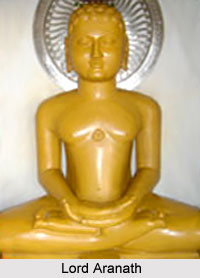 Lord Aranath was the eighteenth Jain Tirthankara of the current age, Avasarpini. As per Jain philosophy, he became a siddha - an enlightened soul which has demolished all of its karma. He was born to Emperor Sudarshan Raja and Queen Devi Rani at Hastinapur in the Ikshvaku dynasty. His birth date is on the 10th day of the Migsar Krishna month of the Hindu calendar. Emperor Dhanpati of Susima city in Mahavideh area took Diksha or vow from Samvar Muni. His rigorous practises helped him acquire Tirthankar-nam-and gotra-karma. He had reincarnated in the Graiveyak dimension of Gods. After completing his age he left his body and from here he descended into the womb of Queen Maha Devi, wife of Emperor Sudarshan of Hastinapur. Besides the fourteen great dreams that precede the concept of a Tirthankara, Queen Maha Devi also experienced another dream. While the queen was pregnant she dreamt of a gem studded wheel Ara. Thus after the birth of the son the Emperor named him Ara Kumar.
Lord Aranath was the eighteenth Jain Tirthankara of the current age, Avasarpini. As per Jain philosophy, he became a siddha - an enlightened soul which has demolished all of its karma. He was born to Emperor Sudarshan Raja and Queen Devi Rani at Hastinapur in the Ikshvaku dynasty. His birth date is on the 10th day of the Migsar Krishna month of the Hindu calendar. Emperor Dhanpati of Susima city in Mahavideh area took Diksha or vow from Samvar Muni. His rigorous practises helped him acquire Tirthankar-nam-and gotra-karma. He had reincarnated in the Graiveyak dimension of Gods. After completing his age he left his body and from here he descended into the womb of Queen Maha Devi, wife of Emperor Sudarshan of Hastinapur. Besides the fourteen great dreams that precede the concept of a Tirthankara, Queen Maha Devi also experienced another dream. While the queen was pregnant she dreamt of a gem studded wheel Ara. Thus after the birth of the son the Emperor named him Ara Kumar.
Gradually when Ara Kumar became young he got married to many beautiful princesses. Later Emperor Sudarshan crowned him as the king and gave the kingdom to Ara Kumar and became an ascetic. Ara Kumar proved to be a kind hearted and powerful ruler who took proper care of his subjects. For some years Arnath ruled as a regional Emperor. Gradually his power and glory spread far and wide. One day during his rule the disc weapon appeared in his armoury. Taking his army he immediately went on for war and vanquished the six continents and became a Chakravarti. His court remained occupied with almost thirty two thousand kings.
After a long and successful rule, one day Emperor Aranath was thinking about the ever changing seasons. The very thought of the nature triggered a chain of sublime thoughts that lead to complete detachment in him. He thus renounced all the wealth, power and glory and became an ascetic. He practise rigorous divine practices and wandered to different places. Travelling far and wide he arrived in the Sahasramra jungle outside Hastinapur after three years. There he stood in mediation under a mango tree. With the fire of higher meditation he burnt all the four vitiating Karmas including illusory, knowledge obstructing, perception obstructing, and power hindering. Consequently he achieved nirvana. His first discourse after achieving nirvana he gave several discourses to people. His first discourse was on the subject of how to win over the enemies like attachment and aversion.
In this first religious assembly thousands of persons became monks including his 32 chief followers headed by Kumbh. He later spends a long period of twenty one thousand years wandering and propagating religious faith. Finally he arrived at Sammethshikhar and achieved nirvana.









